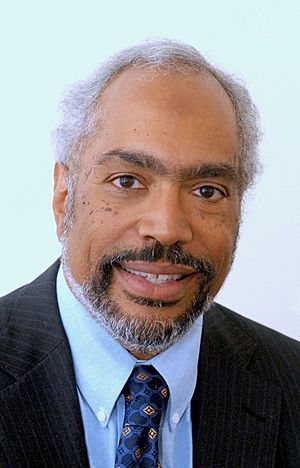Gibor Basri facts for kids
Quick facts for kids
Gibor Basri
|
|
|---|---|
 |
Gibor Basri is an American scientist who studies space, called an astrophysicist. He used to be a professor at U.C. Berkeley. He studied how stars act, how new stars are made, and special small stars called brown dwarfs. He also helped make the university a fair and welcoming place for everyone.
Contents
Early Life and Family
Gibor Basri was born in New York City on May 3, 1951. His father, Saul Basri, was a physics professor at the University of Colorado. His mother, Phyllis Basri, taught modern dance and ballet.
His father was from Iraq and came to America in 1944. His mother was from Jamaica and came to New York to study dance. They met while studying at Columbia University.
Gibor grew up in Fort Collins, Colorado, with his younger brother, David. His family also lived for short times in Burma (1957) and Sri Lanka (1965). In 1974, he met his wife, Jessica Broitman. They had a son in 1991.
Education and Awards
Basri finished his physics degree at Stanford University in 1973. He then earned his Ph.D. in astrophysics from the University of Colorado in 1979. His Ph.D. work was about how light moves through stars. He also studied how stars behave.
After his Ph.D., he went to the U.C. Berkeley astronomy department in 1979. In 1982, he became a professor there. He officially retired in 2015 but still works on projects.
He has received many awards for his work. These include a Miller Research Professorship in 1997. He became a Sigma Xi Distinguished Lecturer in 2000. He also won the Chancellor's Award in 2005. In 2015, he received the Berkeley Citation, which is the highest honor from the campus. In 2016, he won the Carl Sagan Prize for Science Popularization. This award is for making science easy to understand for everyone. In 2023, he became a Fellow of the American Astronomical Society.
Career in Science
Studying Stars and Space
At U.C. Berkeley, Gibor Basri first studied high-energy light from stars. This helped prepare for the Extreme Ultraviolet Explorer (EUVE) satellite. In the 1980s, he started studying star formation. He also looked at young stars called T Tauri stars.
In the 1990s, he helped discover brown dwarfs. These are objects that are bigger than planets but smaller than stars. He became a top expert on them. He also created a way to tell the age of young star groups. This method is called "lithium dating." His discoveries are in the book 50 Years of Brown Dwarfs.
Later, he worked on NASA's Kepler Mission. This mission looked for planets outside our solar system. He used the mission's data to study starspots. These are dark, cooler areas on the surface of stars. This helped him learn more about how stars' magnetic fields work. In 2022, he wrote a book called An Introduction to Stellar Magnetic Fields.
Working for Fairness
Besides his science work, Basri also worked to make universities more fair. From 2007 to 2015, he was the first Vice Chancellor for Equity and Inclusion at U.C. Berkeley.
In this role, he helped create a plan for fairness at the university. He also helped with surveys to understand how people felt about the campus environment. He made sure that fairness was a big part of hiring new staff. He also worked on keeping and promoting people from all backgrounds.
See also
 In Spanish: Gibor Basri para niños
In Spanish: Gibor Basri para niños

